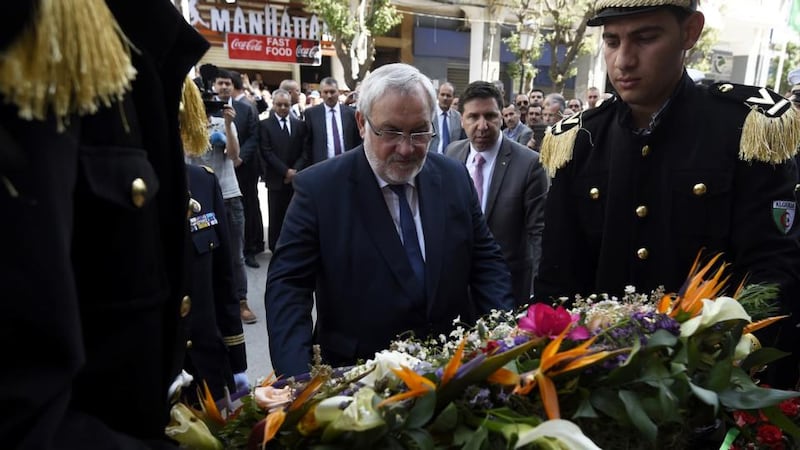Some 8,000 Muslim Arabs gathered in the market town of Sétif, 300km east of Algiers, early on the morning of May 8th, 1945. They were ostensibly there to celebrate the German surrender in Reims the previous evening, and intended to lay a wreath at the monument to Algerian troops who perished in the conflict.
Algeria was the jewel of French colonies, a territory so rich Paris claimed it as an integral part of France. Some 200,000 Algerians had been conscripted into the French army. Sixty thousand were taken prisoner by the Germans.
Banners

The march started peacefully enough, with French, British and Soviet flags fluttering over the demonstrators. But they also carried banners demanding the liberation of imprisoned pro-independence leader Messali Hadj. The young woman at the head of the procession unfurled the green and white flag that had been the emblem of the legendary 19th century leader Abd el-Kader, and that would become the flag of independent Algeria.
French police tried to seize the flag. No one is certain who fired the first shot, but Bouzid Saal (26) staggered out of the crowd, bleeding and clutching the Algerian flag, before he fell dead.
The Arabs began a five-day rampage across the region, searching for Europeans to kill. As recounted by British historian Alastair Horne in A Savage War of Peace, farmers were murdered by their servants of 30 years. Entire towns were looted and burned. Women as old as 84 were raped. Breasts were slashed off. Men's genitals were stuffed in their mouths. By the time it was over, 103 Europeans were dead.
In its euphoria at the end of the second World War, France hardly noticed. But every Algerian was deeply marked by Sétif. The French military retaliated without mercy, engaging in summary executions, flattening more than 40 Arab villages with dive bombers, and bombarding the coast from a cruiser in the Mediterranean. Radio Cairo claimed 45,000 Arabs were killed. Most historians use the figure 6,000.
Sétif was the point of no return, after which the 1954-1962 Algerian war of independence became inevitable. "The abyss between the two populations, European and Muslim, was formed during these events," Algerian historian Belkacem Recham says in Maghreb 39-45, a documentary by Jean- Noel Jeanneney and Bernard George, broadcast by France 5 on May 3rd.
Poor harvests
Algeria had known two years of poor harvests. When Albert Camus visited his native Algeria that year, he was shocked to see children fighting with dogs for the contents of rubbish bins. The independence movement spread rumours that the French were deliberately starving Arabs.
During the war, Algerians, Moroccans and Tunisians comprised 14 French army divisions totalling 340,000 men. "The French colony only admits equality with Muslim Algeria on one level: sacrifice on the battlefields," Ferhat Abbas, a pharmacist from Sétif and the most moderate of independence leaders, wrote in his 1943 Manifesto of the Algerian People.
In the 1930s, Abbas had advocated assimilation of Algerian Muslims into France. When the war started, he volunteered to fight for the La Mère Patrie. But events persuaded him independence was the only solution. He asked Gen Charles de Gaulle, leader of the Free French Forces, to create “a democratic Algerian state, federated with France”.
“In the terrible situation that France was in, there were more urgent questions to resolve,” de Gaulle said later.
Most of the leaders of the future National Liberation Front fought in the French army, where they received lower pay and benefits and were barred from promotions.
"The fact that France collapsed so quickly in 1940 broke the myth of the invincible French," Moroccan historian Mohamed Kenbib tells Jeanneney in Maghreb 39-45. Because Algeria was loyal to the collaborationist leader Marshal Pétain, the British sank the French fleet at Mers- el-Kebir, near Oran with the loss of 1,300 French lives. Over three confusing years, Algeria's French military rulers shifted from collaboration to the Allied camp.
Winston Churchill convinced Franklin D Roosevelt that North Africa was the "soft underbelly" of Europe. The Americans staged simultaneous landings in Algeria and Morocco in "Operation Torch" on November 8th, 1942. (British participation was limited because of bitterness over Mers-el-Kebir.)
Germany used the landings as a pretext to extend occupation into the “free zone” of France. Algeria became the staging ground for the war against Rommel’s troops in North Africa, and for landings in Italy and Provence.
Dazzled
The Algerians were dazzled by American military power. Some harboured a vague hope the US would liberate them from France. Ferhat Abbas called on US officials, citing the Atlantic Charter’s promise of self-determination.
Seventy years after the Sétif massacre, France’s relations with its former colony have never been better, fuelled by shared economic interests and the battle against jihadism in the Sahel region. For the first time, Paris sent an official, Jean-Marc Todeschini, the secretary of state for war veterans, to commemorations of the Sétif massacre. Todeschini laid a wreath at the mausoleum of Saal Bouzid, the first Arab killed on May 8th, 1945.
President François Hollande denounced the French colonisation of Algeria as “a profoundly unjust and brutal system” in a December 2012 speech before the Algerian parliament. He remembered the Sétif massacre in particular. “On the day when the world triumphed over barbarity, France betrayed her universal values,” Hollande said.










